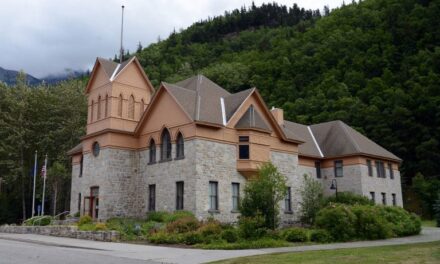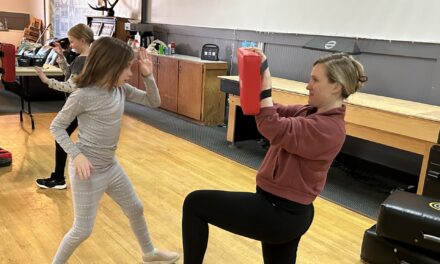
Haines/Deishu and the Chilkat Peninsula (Photo via Wikipedia)
The Chilkoot Indian Association has a number of community initiatives in the works, focused on storm disaster recovery, food security, cultural and economic development, and more. KHNS’ Corinne Smith checked in with tribal administrator Harriet Brouillette for an update on several ongoing community projects around Haines.
The following has been edited for length and clarity.
KHNS: Thank you Harriet, for joining us today. So the Chilkoot Indian Association has a lot of programs and community projects ongoing. Can you talk a bit about the past couple of years, kind of how you got here?
Brouillette: Sure. When I first started working as a tribal administrator, the tribe was in financial dire straits, we were behind on our audit, we were behind on our reporting. And really, no one wanted to take on what looked like it could be the end of the tribe, but I have a degree in tribal and public administration and was offered an opportunity to work for the tribe, as the administrator and I accepted the challenge. My initial thought was that it would take us about four to five years to complete the back audit, and to get ourselves into a transparent position with the federal government. And then once we were in a transparent position, then we could start applying for additional funding. That happened in three years, rather than four to five. And that in itself is a major accomplishment. And that comes from having a really good support team, having a fantastic financial director, and Leslie Graham, having good managers need to have our programs and having them understand what is expected of them so that they can get the job done properly. So we pulled ourselves out of the dark position. And as the staff was working towards our financial clarity, the tribal council was working on a strategic plan. So part of that strategic plan was to focus on cultural development, some financial security, economic development, those sorts of programs.
KHNS: Great. So the food box program, can you tell us a bit about that, and how it’s grown over the last few months?
Brouillette: So this program is something that we signed up with, it’s a program through the USDA, it was set up actually to run in lieu of a food stamp program on reservation land. … And what it does is provide food for families who may be struggling. In our community, we’re lucky enough to be able to provide the food to any low income family, or any family in need who applies, whether they’re tribal members or not. Last time I checked there were around 50 families. So the program has a wide variety of food items. Usually one family or one two-person family walks away with about four boxes of food per month. And a family of maybe four or five will walk away with 10 plus boxes of food. So there’s quite a bit of food. We have a formula that we use that’s provided by USDA, so that we can kind of figure out what each family’s needs might be. We offer things such as beef and pork, fish, chicken, turkey. What they’re trying to do now is to offer us foods that are more regional. So rather than sending us, like buffalo and catfish, they’ll send us salmon and elk meat. Yeah, so they try to provide some traditional foods. But the program is fairly new in Alaska. We have been getting some exotic foods, which is fun, you know, trying buffalo and catfish is interesting. But we get fruit, too. We get pears, apples, oranges, various other fruits, eggs, milk.
KHNS: So it’s supplied, it’s not like a voucher program at the grocery store.
Brouillette: Correct. Yeah, we actually send an order in to the regional office, which is in Anchorage, and we let them know how many people we have on our program and what inventory we have left in our pantry – the last time I checked, we had 50 families. And they send us an order of frozen goods and refrigerated dry goods. So we get an order once a month, and it’s usually a few thousand pounds of food. And when it arrived, we take a day to do inventory, and to rotate inventory. And then we start calling folks to see what they might be wanting or needing. And that usually takes about two weeks. So it’s not a simple program where you just throw food in a box and give it out. We actually have to, we have to put things in inventory and then take them out just like a grocery store.
KHNS: That’s great. Okay, storm recovery assistance. The Chilkoot Indian Association has been very active in supporting the disaster recovery effort. So can you talk a bit about that project work, and what is the focus now?
Brouillette: The focus now is definitely rebuilding. We have, over the last year, spent time monitoring and assessing damage and monitoring as far as mold. There are homes that were watered damaged. But it seems, a few months ago, they were fine. But now people are finding that they are growing mold. And most of the projects are fairly small. But there are a few larger projects that we have been working with the Haines Long Term Recovery Group. The funds that come to our community are a bit of a blend of funding from various different agencies or organizations. CIA actually just happens to be one of a few that are pitching in to help with recovery. We were lucky enough last month to have Team Rubicon in Haines to help with some of the demolition. Team Rubicon will be coming back to town in November to help with rebuilding at least two homes, in our community, and possibly more.
KHNS: Yes, that’s great news, for Team Rubicon to help with immediate construction.
Brouillette: Right. Team Rubicon is built on volunteer work from US military veterans. So they travel on their own dime, they come up here and volunteer, or they travel to disasters to volunteer to help, mostly with cleanup. But they liked Haines so much, and we were ready for them. We were ready to provide everything that they needed, they decided that they would come back and help again. So that happened because of this community. And because of folks involved in the Long Term Recovery Group, making sure that they had places to stay, that they food to eat, and tools to use, and transportation. So it all worked out really well. And that kudos to Sarah Chapell and Sylvia Heinz. Those two I think were instrumental in making sure that the Team Rubicon project went well.
KHNS: Is there anything else you’d like to add, that you’d like to share with the community?
Brouilette: Our trail system is open for use. People are more than welcome to walk or ride their bikes on our wonderful little trail system in the subdivision. We just caution people right now to be a little bit careful because it’s slippery. And there are still bears and moose in that area. If somebody runs into an issue where it’s too slippery, or there’s a tree down across the trail, I would request respectfully that folks come into the office and let us know so that we can take care of it immediately. We’re more than happy to make sure the trail is clear and safe.”
KHNS: Thank you so much, Harriet. Really appreciate you taking the time.
Brouillette: Of course, anytime.
Tune in this week for part two of the conversation on the tribe’s upcoming projects, including a new waterfront restaurant, tourism recovery plans, and Tlingit language revitalization.








